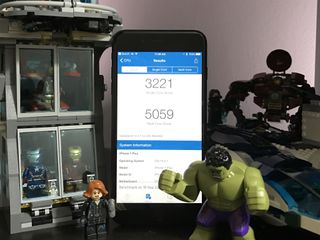Why Apple A10 leads the mobile chipset industry

I've been talking about Apple's silicon advantage for a few years now but it still doesn't get the recognition is really deserves. Johny Sjrouji's hardware technology team has brought Apple from nowhere to become the best chip designers in mobile — and arguably beyond — and there's no sign of them slowing down. If anything, Apple is spending the money to let them run as fast as they possibly can. Look no further than iPhone 7's HURRICANE.zephyr.
From the Linley Group:
The massive Hurricane CPU improves performance by 35% over the previous-generation Twister, boosting both the clock speed and the per-clock performance. The smaller Zephyr CPU helps the iPhone 7 extend battery life compared with its predecessor.
That's the advantage of the big.LITTLE design. With the standard design, when performance improves to a certain point, you lose efficiency on the low end. Hurricane can go high because Zephyr's there to fill in the low.
Part of Apple's advantage is its ability to spend money. Die area is expensive for a processor built in leading-edge 16nm FinFET technology, and Hurricane uses plenty of it. A single Hurricane CPU measures 4.18mm2, about twice the size of other high-end mobile CPUs. Because Apple sells phones, not chips, adding a few dollars of die cost is of little importance if the resulting high performance enables it to sell more $600 products.
In other words, Qualcomm has to sell its chips, which is a limiting factor. Apple doesn't. Apple also doesn't have to support multiple architectures or vendors. They can build exactly what they need and match the atoms to the bits.
The second new CPU core in the A10 is appropriately code-named Zephyr (a light breeze). It's much smaller than Hurricane, suggesting that it uses a simpler microarchitecture. The die photo shows it has 32KB instruction and data caches instead of the 64KB caches in Hurricane. Excluding cache, however, Zephyr is nearly twice as large as Cortex-A53, indicating it's more complex than that design.
Barron's report adds:
Gwennap ends on an ominous note for Intel: "Apple's CPU prowess is beginning to rival Intel's. In fact, the new Hurricane could easily support products such as the MacBook Air that today use lower-speed Intel chips."
ARM-based Macs have been rumored for years. What I'm really curious about, though, is to see where Apple takes the silicon next. The possibilities are intriguing to say the least.
Of course, they're running low on wind-inspired codenames. On behalf of Canada, I'd like to offer BLIZZARD.flurry.
Master your iPhone in minutes
iMore offers spot-on advice and guidance from our team of experts, with decades of Apple device experience to lean on. Learn more with iMore!

Rene Ritchie is one of the most respected Apple analysts in the business, reaching a combined audience of over 40 million readers a month. His YouTube channel, Vector, has over 90 thousand subscribers and 14 million views and his podcasts, including Debug, have been downloaded over 20 million times. He also regularly co-hosts MacBreak Weekly for the TWiT network and co-hosted CES Live! and Talk Mobile. Based in Montreal, Rene is a former director of product marketing, web developer, and graphic designer. He's authored several books and appeared on numerous television and radio segments to discuss Apple and the technology industry. When not working, he likes to cook, grapple, and spend time with his friends and family.
Most Popular



